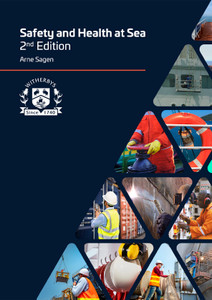
This book provides clear and straightforward guidance on the responsibilities of the Shipboard Safety Officer. It focuses on what you need to know to perform this role and how to develop a good safety culture on board. It discusses how to approach the tasks that you are likely to be presented with, what they might mean and some of the implications or actions that may result from them.
The main role of a Safety Officer is to act as a focal point for all occupational health and safety matters arising on board ship. Although the role is advisory and does not actually carry the company’s responsibility for health and safety, it plays a vital role in responding to identified hazards and maintaining onboard safety.
This may seem a daunting task, but the book outlines clearly how the Safety Officer can respond to that role and deal with their duties in a professional and effective manner.
The book advises on selection of a suitable Safety Officer, applicable IMO regulations, shipboard safety organisation, development of positive onboard safety culture, risk assessment and incident investigation and prevention.
There are two ways to identify a suitable candidate for the role of Safety Officer, first through formal definitions and requirements and second, by identifying the potential opportunity it represents for both the individual and the ship.
The formal requirement for a Safety Officer is that they must be competent and have at least 2 years’ consecutive sea service, served after reaching the age of 18. The Safety Officer onboard an oil tanker must have at least 6 months’ service on such ships.
All seagoing ships that employ more than 5 people, apart from fishing vessels, must have a Safety Officer. The appointment is recorded in the official logbook. The Master can be appointed, although this is not recommended. The Safety Officer has a number of defined responsibilities and these are discussed in Section 1.2.
The company should appoint a suitable person, capable of encouraging a positive safety culture onboard, who has good interpersonal and administrative abilities. The Safety Officer should be observant and impartial.
A Safety Officer should:
- Be appointed if there are more than 5 workers on board
- have the appointment recorded in the Official Log Book (OLB)
- have received formal training, ie attended a Safety Officer training course
- act as an independent safety adviser on behalf of the company
- not normally be the Master
- not normally be appointed to provide medical treatment onboard.
The Safety Officer, by necessity of the manning situation, inevitably has more than ‘one hat’ and an individual may not be the most suitable appointment if the role of Safety Officer conflicts with his primary job onboard.
Contents
1. The Role of the Safety Officer
1.1 Who is the Safety Officer?
1.2 Principal Duties of the Safety Officer
1.3 Characteristics of a Good Safety Officer
2. Background to the Creation of the Role
2.1 International Safety Management (ISM) Code and Safety Culture
2.2 ILO
2.3 International Organization for Standardization (ISO), Safety Management and Safety Culture
2.4 Health, Safety and Environmental Policy
2.5 The Employer
2.6 Competent Person
3. The Safety Organisation Onboard Ship
3.1 Shipboard Safety Organisation
4. Safety Culture
4.1 Communication Shipboard Safety Officer Notes
4.2 Motivation
4.3 Role of Communication and Motivation in Shipboard Safety
4.4 Creating a Safety Culture
5. Risk Assessment
5.1 Legal Requirements for Risk Assessment
5.2 Task Selection
5.3 Hazard Identification (HazID)
5.4 Evaluating Hazards and Assessing Risks
5.5 Controlling the Risks and Action Plan
5.6 Permit to Work (PTW) System
5.7 Checklists
5.8 Documentation for Risk Assessment
5.9 Risk Assessment – The Simplified Steps
6. Incident Investigation and Prevention
6.1 Incident Investigation
6.2 Investigation Process
6.3 Investigation Steps
6.4 Interpreting the Facts
6.5 Report Writing
6.6 Initiating Corrective Actions
6.7 Authorities to whom Reports are Sent
Appendix 1 – Codes and Legislation
Appendix 2 – MAIB Incident Report Form and MGN 289
Glossary of Main Terms
Acronyms and Abbreviations
References
Bibliography
Abdul Khalique
Master Mariner, MICS, PG Cert (Shipping), MSc (CBIS), HND Nautical Science, BSc (Maritime Studies)
After spending some time at sea, Abdul pursued a shore-based career. He was a Principal Lecturer in Maritime and Offshore Safety at Warsash Maritime Academy, a role that led him to the position of Head of the LJMU Maritime Centre at Liverpool John Moores University.
- Number of Pages:
- 131
- ISBN:
- 9781856094023
- Binding Format:
- Paperback
- Book Height:
- 230 mm
- Book Width:
- 150 mm
- Weight:
- 0.5 kg
- Author:
Abdul Khalique
- Published Date:
- September 2010
- Preview:
- Yes
- Publication Date:
- September 2010




